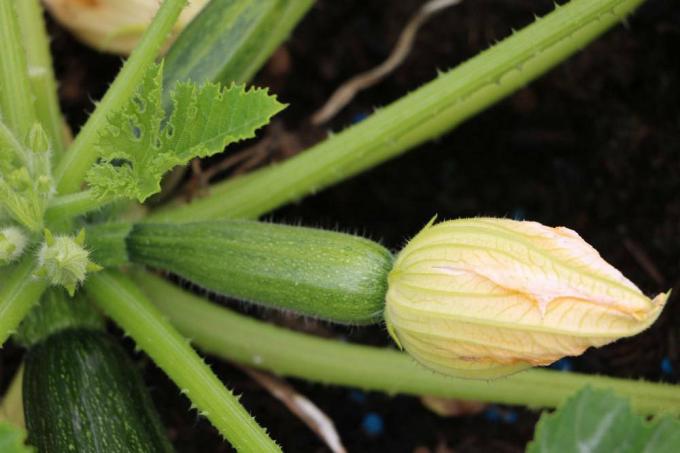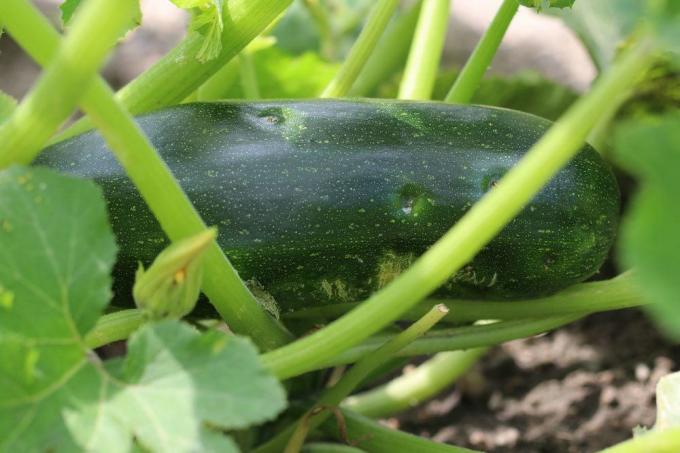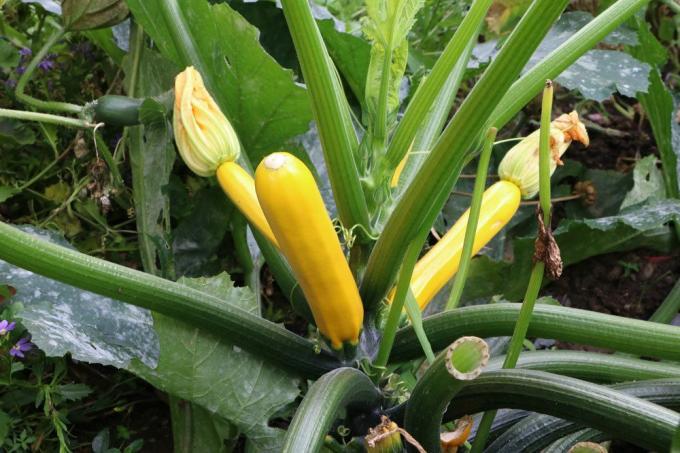
table of contents
- Best harvest time
- Harvest quickly
- Harvest tips
- Edible flowers
- taste
- storage
- Crop rotation
Zucchini are garden pumpkins and can be found in many home gardens. This is due to the uncomplicated cultivation and the multiple usable fruits, which by the way come in different shapes and colors. Both the fruits and the flowers are edible. If you discover the first zucchini, things go fast. It is harvest time and the pumpkin fruits should be harvested quickly. They are most tender and aromatic when they are young.
Best harvest time
The main harvest season for zucchini, which is one of the most productive vegetables, extends from June to October. The point in time at which the harvest can take place and the yield mainly depend on the prevailing weather. In cool and wet summers it can e.g. B. It can happen that the plants set many flowers, but these hardly develop fruit or that they fall off the plant and spoil at a very young stage. Usually this is due to the fact that fertilization was not optimal.
You should start harvesting as soon as the fruits are 15-20 cm long, then they are particularly tender and tasty. On the other hand, if you let them fully mature, which happens in a very short time, they can take on gigantic proportions. However, you have to make significant compromises in terms of taste and consistency, because the bigger the zucchini become in taste and woody. When fully ripe, these club-shaped fruits can reach a length of up to 70 cm. Basically, the last zucchini should be harvested before the first frost.

Harvest quickly
Like the cultivation, harvesting the fruit is simple and straightforward. To separate them from the plant, you can lift them up a little and carefully twist them off. Or you cut them off with a sharp knife. The disadvantage of cutting off is that a small stump remains on the plant, which rots relatively quickly and thus represents an entry point for germs and bacteria. For this reason, turning is the better alternative.
- Harvest this pumpkin vegetable as young as possible
- Such an early harvest time does not reduce the yield, on the contrary
- Plants tirelessly and comparatively quickly produce new fruits
- Always harvest quickly, preferably several times a week
- Fruits that stay on the plant too long become bland and woody
- Plants are then only concerned with supplying these fruits
- subsequent fruits fall off immediately after flowering or rot on the plant
- consequently it lacks the energy for new growth
- this in turn can noticeably reduce the yield
- Any rot that occurs can promote viral diseases and powdery mildew
However, larger specimens have one advantage, they can be stored better. If, on the other hand, harvested regularly and quickly, a single plant can produce between 10 and 20 fruits, which corresponds to a yield of around 3 - 5 kg per square meter. Ultimately, the yield depends on the variety and how long you let the fruit ripen on the plant.
Tip: As a rule, 2-3 well-developed plants can provide a family of four with plenty of fresh vegetables throughout the summer.
Harvest tips
Tips for a good harvest
In order for fruits to develop at all, the female flowers have to be pollinated, which is usually done by insects. The time corridor for this is limited, however, because pollination of the female flowers is only possible for a few hours when the flowers are open. Unfavorable weather with a lot of rain, wind and cold can mean that only a few insects are on the move and pollination may not occur.

Then there is the possibility of pollination by hand. To do this, choose a male flower that is well developed and fully open at this point and break it off. Then remove the petals and stroke their stamens over the stigma of the female flowers. So you can pollinate several females with just one male flower.
Alternatively, you can brush the male stamens with a fine brush and use it to transfer the pollen to the female flowers. After successful fertilization, the ovaries swell and the petals begin to wither. To protect against fungal pathogens due to damp weather, it is advisable to remove the withered petals.
Edible flowers
These plants, which belong to the garden pumpkins, not only produce tasty fruits, the bright yellow, extremely decorative flowers are also edible and a real delicacy. The zucchini develops male and female flowers, whereby only the female fruits develop. Male flowers already show small fruit sets when they bloom, which can be easily recognized by them.

They can be harvested just before the flowers open and then eaten raw, baked, fried, grilled or deep-fried. Female flowers can be recognized by the short stalk and the large ovary under the yellow petals. Since the male flowers are needed for fertilization, one should not harvest too many of them.
taste
Beware of bitter-tasting zucchini
If a fruit tastes bitter regardless of the timing, it should not be eaten. Responsible for this is the substance cucurbitacin, a poison that is mainly found in ornamental gourds. This poison was bred out of specimens that are offered in trade. However, under certain conditions, especially through self-rearing with self-harvested seeds, it can form again. This can also happen if they have been grown near ornamental pumpkins or if it is very warm during storage, which leads to stress and under stress the vegetables produce this poison.

storage
Store / make durable
- Do not store freshly harvested fruits at temperatures below 10 degrees
- they can be kept for about 12 days
- the younger the fruit, the shorter the shelf life
- Avoid storage close to apples or pears
- Both types of fruit emit the ripening gas ethylene
- this allows neighboring vegetables to ripen faster
- consequently, the zucchini would spoil faster
Tip: To preserve the fruit by freezing is not recommended, because this would change the consistency of the fruit flesh significantly, making it soft and watery. It is best to eat or process these vegetables immediately after harvesting, when they are still fresh and crisp.

Crop rotation
Note crop rotation and mixed culture
When growing this vegetable plant, it is essential to ensure that the crop rotation is adhered to and that there are suitable plant neighbors. affect yields both positively and negatively. Zucchini should be grown in the same location no more than every 3-4 years to prevent the colonization of harmful soil fungi. In addition, a mixed culture with onions, beans, peas, corn, celery, garlic, basil, nasturtiums, thyme and marigolds are beneficial for these vegetables. On the other hand, planting next to potatoes is not recommended.



